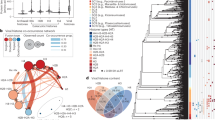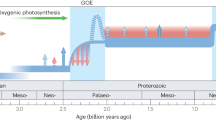Abstract
SINCE the first reports of satellite DNAs in the Jonah crab, Cancer borealis1, and in the mouse2, satellite DNAs have been described for a number of animal species, both vertebrate and invertebrate. We now report our findings on the satellite DNAs of five species of Crustacea. We find at least one and in some instances two DNA satellites in each species and were surprised to discover that two distinctly different satellite DNAs band at the same density, 1.677 g/cm3, in CsC1. DNAs banding at this density are usually assumed to be “crab poly d(A–T)”, the satellite DNA composed of more than 90 per cent alternating adenylate and thymidylate residues3,4. It now seems that this cannot be assumed without further characterization of the DNA species having that density. We emphasize that the satellites described in this note are not mitochondrial in origin: even though we find a mitochondrial DNA of ρ = 1.688 g/cm3 in each of the five species, the quantity is too small to be detectable in a “total” DNA preparation. These data will be presented elsewhere.
This is a preview of subscription content, access via your institution
Access options
Subscribe to this journal
Receive 51 print issues and online access
$199.00 per year
only $3.90 per issue
Buy this article
- Purchase on Springer Link
- Instant access to full article PDF
Prices may be subject to local taxes which are calculated during checkout
Similar content being viewed by others
References
Sueoka, N., J. Mol. Biol., 3, 31 (1961).
Kit, S., J. Mol. Biol., 3, 711 (1961).
Josse, A., Kaiser, A. D., and Kornberg, A., J. Biol. Chem., 236, 864 (1961).
Skinner, D. M., Proc. US Nat. Acad. Sci., 58, 103 (1967).
Marmur, J., J. Mol. Biol., 3, 208 (1961).
Flamm, W. G., Bond, H. E., and Burr, H. E., Biochim. Biophys. Acta, 129, 310 (1906).
Graham, D. E., Anal. Biochem. (in the press).
Smith, M., J. Mol. Biol., 9, 17 (1964).
Luck, D. J. L., and Reich, E., Proc. US Nat. Acad. Sci., 52, 931 (1964).
Klett, R. P., Chabot, I. M., Smith, M., and Hart, J. F. L., Canad. J. Biochem., 47, 829 (1969).
Counts, W. E., and Flamm, W. G., Biochim. Biophys. Acta, 114, 628 (1966).
Kirby, K. S., Biochem. J., 66, 495 (1957).
Massie, H. R., and Zimm, B. H., Proc. US Nat. Acad. Sci., 54, 1641 (1965).
Massie, H. R., and Zimm, B. H., Proc. US Nat. Acad. Sci., 54, 1636 (1965).
Skinner, D. M., and Triplett, L., Biochem. Biophys. Res. Commun., 28, 892 (1967).
Morgan, A. R., and Wells, R. D., J. Mol. Biol., 37, 63 (1968).
Schildkraut, C. L., Marmur, J., and Doty, P., J. Mol. Biol., 4, 430 (1962).
Mandel, M., Igambi, L., Bergendahl, J., Dodson, jun., M. L., and Schelgen, E., J. Bact., 101, 333 (1970).
Author information
Authors and Affiliations
Rights and permissions
About this article
Cite this article
SKINNER, D., BEATTIE, W., KERR, M. et al. Satellite DNAs in Crustacea: Two Different Components with the Same Density in Neutral CsCI Gradients. Nature 227, 837–839 (1970). https://doi.org/10.1038/227837a0
Received:
Issue Date:
DOI: https://doi.org/10.1038/227837a0
This article is cited by
-
Isolation of histone genes from unfractionated sea urchin DNA by subculture cloning in E. coli
Nature (1975)
-
Differential Under-replication of Satellite DNAs during Drosophila Development
Nature New Biology (1972)
-
Homologies of repetitive DNA sequences among Crustacea
Chromosoma (1972)
-
The chromosomal localization of a heavy satellite DNA in the testis of Plethodon c. cinereus
Chromosoma (1971)
Comments
By submitting a comment you agree to abide by our Terms and Community Guidelines. If you find something abusive or that does not comply with our terms or guidelines please flag it as inappropriate.



